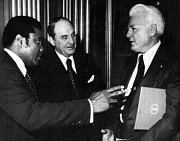An official website of the United States government
Here’s how you know
Official websites use .gov
A .gov website belongs to an official government organization in the United States.
Secure .gov websites use HTTPS
A lock ( ) or https:// means you’ve safely connected to the .gov website. Share sensitive information only on official, secure websites.
About EEOC
News and Information
Laws and Enforcement
Programs and Performance
Data and Analytics
Inside EEOC
Employees & Applicants
Filing a Charge of Discrimination
Discrimination by Type
Employers / Small Business
Small Business Resource Center
Discrimination by Type
Federal Agencies
Federal Employees & Job Applicants
Resources in Other Languages
Chair William H. Brown III and AT&T officials sign landmark consent decree, January 18, 1973
The complaint of blacks is that they have trained hundreds and hundreds of white persons who have gone on to become their bosses and their bosses’ bosses, testified Pluria Marshall . . . .
The four days of hearings also brought out the fact that there was a formidable distance between a firm’s official hiring practice and what really occurs in the personnel office. In Houston, where there are jobs available, many firms still require all employees to have at least a high school diploma. This automatically disqualifies many minority groups, particularly Mexican Americans, and sets standards far higher than indicated necessary by job analysis, according to Dr. William H. Enneis, an EEOC psychiatrist.
Another hurdle for minorities is the testing method used by most firms, he said. Most testing falls short of any mark of achievement . . . most of the time the tests are not applied correctly, they are not closely related to the job, some purposely weed out minorities and — most important — are based on the assumption that minority applicants have been exposed to the same general opportunity as Caucasians.
Many of the black leaders who testified said that despite grandiose statements from large industries, hiring practices still go no further than tokenism and many Negroes are employed simply as ‘window dressing’ for some firms.
The hearing was unique in one respect. It was the first time that a number of women had testified at such length about sex discrimination in jobs.
The amendments result in the following:
(1) EEOC has litigation authority. If the agency cannot secure an acceptable conciliation agreement, it has the option of suing nongovernment respondents — employers, unions, and employment agencies.
(2) Educational institutions are subject to Title VII. Congress found that discrimination against minorities and women in the field of education was just as pervasive as discrimination in any other area of employment.
(3) State and local governments are no longer exempt from Title VII. Removal of this exemption results in 10 million more employees being immediately added to Title VII’s coverage.
(4) The Federal Government is subject to Title VII. Federal executive agencies and defined units of the other branches must make all personnel actions free from discrimination based on race, color, sex, religion or national origin.
(5) The number of employers covered by Title VII is increased by reducing the number of employees (from 25 to 15) needed for an employer to be covered by the Act.
(6) Charging parties have a longer period of time to file their charges, 180 or 300 days rather than 90 or 210 days. Additionally, charging parties now have 90 days rather than 30 days to file a lawsuit after EEOC has informed them that it is no longer working on their charge. This extension of time affords charging parties a better chance to find a lawyer if they wish to pursue their charges in court.

EEOC Chair Powell, Attorney General Saxbe and Labor Secretary Brennan discuss settlement with steel companies.
Chairman John Powell
Chairman Lowell W. Perry
Chairwoman Eleanor Holmes Norton
131 M Street, NE
Washington, DC 20507
1-800-669-6820 (TTY)
1-844-234-5122 (ASL Video Phone)
Call 1-800-669-4000
For Deaf/Hard of Hearing callers:
1-800-669-6820 (TTY)
1-844-234-5122 (ASL Video Phone)
info@eeoc.gov
EEOC History: 1970 – 1979 – U.S. Equal Employment Opportunity Commission (.gov)



